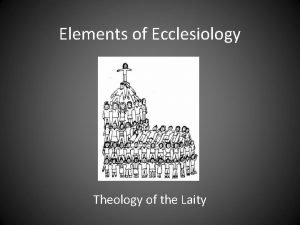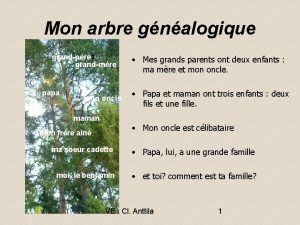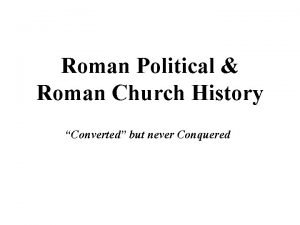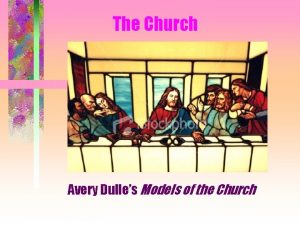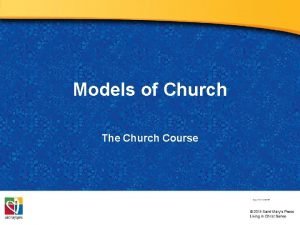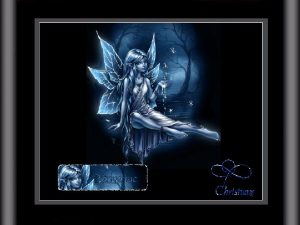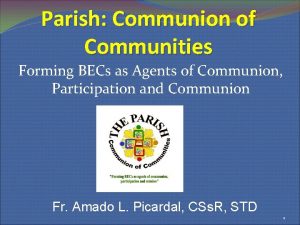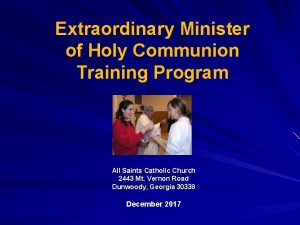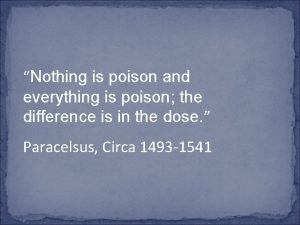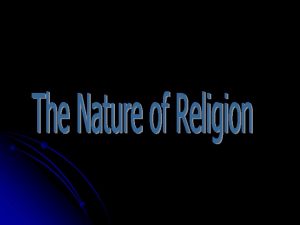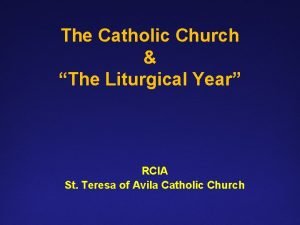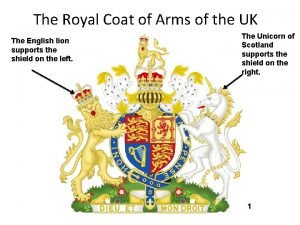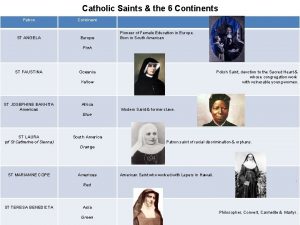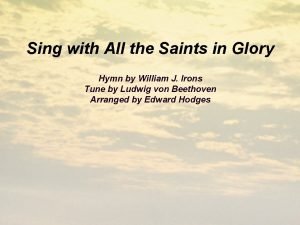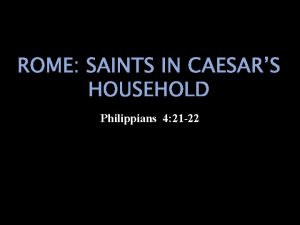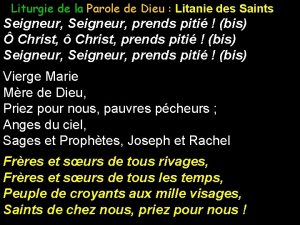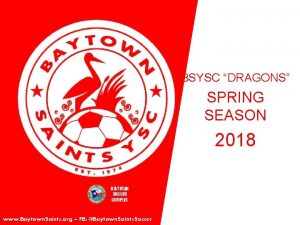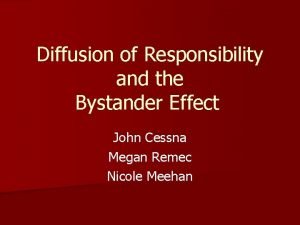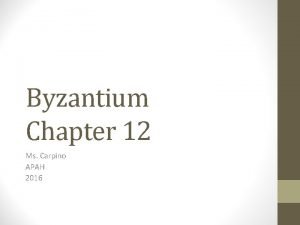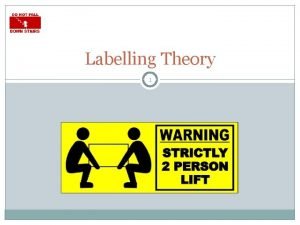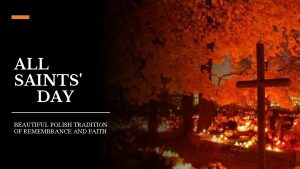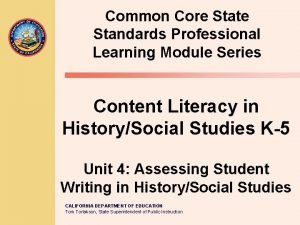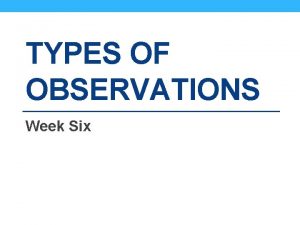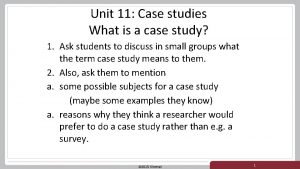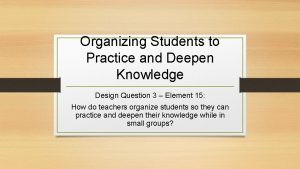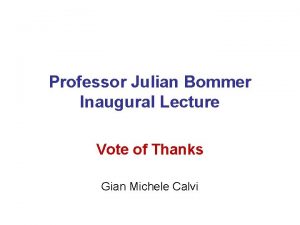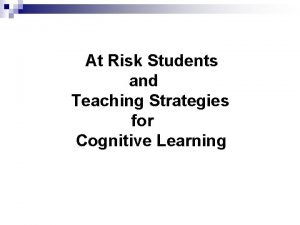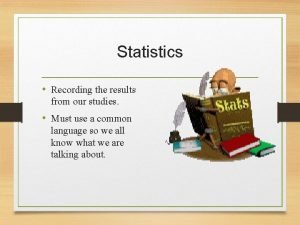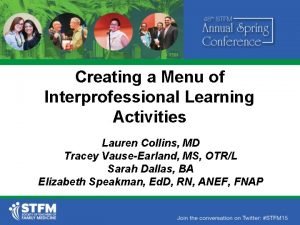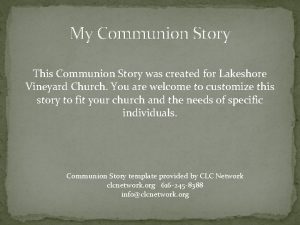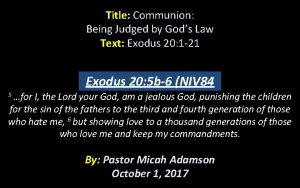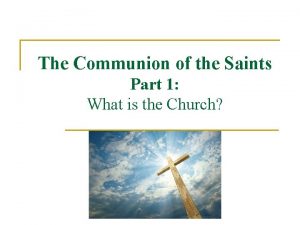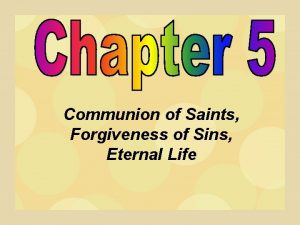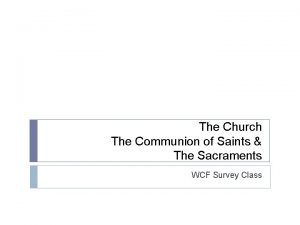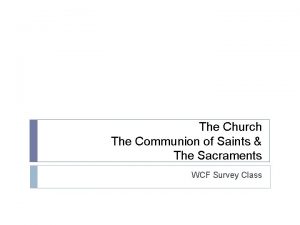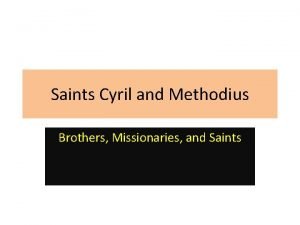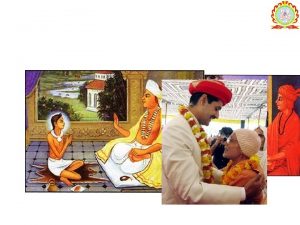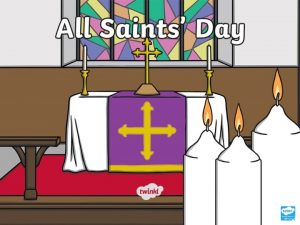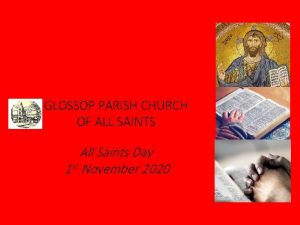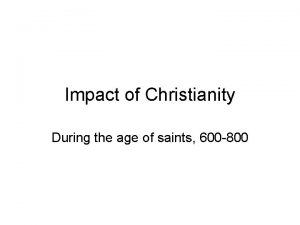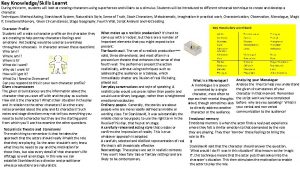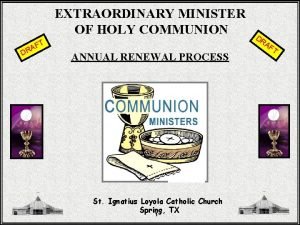Communion of Saints During this term students will












































































- Slides: 76

Communion of Saints

During this term students will learn to. . . Deep Learning Intentions I am learning to identify and describe many ways in which faith is lived out in the lives of believers past and present. Surface Learning I am learning to demonstrate an understanding of the term ‘communion of saints’. I am learning to examine the spiritual and corporal works of mercy. I am learning to select and use evidence from Scriptural texts.

They will demonstrate their learning when they… I can identify and describe some characteristics of Christian faith as a gift of God (e. g. initiated by God (gift), the work of the Holy Spirit, conversion). I can identify ways in which faith is lived out in the life of believers – personally and communally. Success Criteria ‘Communion of saints’ is a term which describes the spiritual bond that exists, through Baptism, between all the members of the Church, living and dead. I can communicate an understanding of the term ‘communion of saints’. I can identify spiritual and corporal words of mercy. I can make connections between the spiritual and corporal words of mercy and the direct scriptural foundations. I can reflect on and express my personal response to the challenge to serve other through the words of mercy.

Learning Intentions Deep Learning I am learning to identify and describe many ways in which faith is lived out in the lives of believers past and present. Surface Learning I am learning to demonstrate an understanding of the term ‘communion of saints’. I am learning to examine the spiritual and corporal works of mercy. I am learning to select and use evidence from Scriptural texts. They will demonstrate their learning when they… Success Criteria I can identify and describe some characteristics of Christian faith as a gift of God (e. g. initiated by God (gift), the work of the Holy Spirit, conversion). I can identify ways in which faith is lived out in the life of believers – personally and communally. ‘Communion of saints’ is a term which describes the spiritual bond that exists, through Baptism, between all the members of the Church, living and dead. I can communicate an understanding of the term ‘communion of saints’. I can identify spiritual and corporal words of mercy. I can make connections between the spiritual and corporal words of mercy and the direct scriptural foundations. I can reflect on and express my personal response to the challenge to serve other through the words of mercy.

Communion of Saints Session 1

Learning Intentions Deep Learning I am learning to identify and describe many ways in which faith is lived out in the lives of believers past and present. Surface Learning I am learning to demonstrate an understanding of the term ‘communion of saints’. I am learning to examine the spiritual and corporal works of mercy. I am learning to select and use evidence from Scriptural texts. They will demonstrate their learning when they… Success Criteria I can identify and describe some characteristics of Christian faith as a gift of God (e. g. initiated by God (gift), the work of the Holy Spirit, conversion). I can identify ways in which faith is lived out in the life of believers – personally and communally. ‘Communion of saints’ is a term which describes the spiritual bond that exists, through Baptism, between all the members of the Church, living and dead. I can communicate an understanding of the term ‘communion of saints’. I can identify spiritual and corporal words of mercy. I can make connections between the spiritual and corporal words of mercy and the direct scriptural foundations. I can reflect on and express my personal response to the challenge to serve other through the words of mercy.

What does communion mean? Where have you heard this word before? Who were the Saints? What is the base word? So what you do think ‘communion of saints’ mean? https: //www. youtube. com/watch? v=UOLYUWDa 3 r. M

Baptism What is the initial initiation of us into the Catholic faith?

Baptism What are the symbols of baptism? Baptism Why is baptism important to Christians? Is there scripture that give us reason for why baptism is important?

Matthew 3: 13 -17 (NRSV) The Baptism of Jesus 13 Then Jesus came from Galilee to John at the Baptism & Scripture Jordan, to be baptized by him. 14 John would have prevented him, saying, “I need to be baptized by you, and do you come to me? ” 15 But Jesus answered him, “Let it be so now; for it is proper for us in this way to fulfill all righteousness. ” Then he consented. 16 And when Jesus had been baptized, just as he came up from the water, suddenly the heavens were opened to him and he saw the Spirit of God descending like a dove and alighting on him. 17 And a voice from heaven said, “This is my Son, the Beloved, [a] with whom I am well pleased. ”

Activity Baptism & Scripture and images and baptism. Explore more.

Communion of Saints Session 2

Learning Intentions Deep Learning I am learning to identify and describe many ways in which faith is lived out in the lives of believers past and present. Surface Learning I am learning to demonstrate an understanding of the term ‘communion of saints’. I am learning to examine the spiritual and corporal works of mercy. I am learning to select and use evidence from Scriptural texts. They will demonstrate their learning when they… Success Criteria I can identify and describe some characteristics of Christian faith as a gift of God (e. g. initiated by God (gift), the work of the Holy Spirit, conversion). I can identify ways in which faith is lived out in the life of believers – personally and communally. ‘Communion of saints’ is a term which describes the spiritual bond that exists, through Baptism, between all the members of the Church, living and dead. I can communicate an understanding of the term ‘communion of saints’. I can identify spiritual and corporal words of mercy. I can make connections between the spiritual and corporal words of mercy and the direct scriptural foundations. I can reflect on and express my personal response to the challenge to serve other through the words of mercy.

Scripture Why does the church then say we need to be baptised?

Matthew 3 : 1 -12 (NRSV) Scripture The Proclamation of John the Baptist 3 In those days John the Baptist appeared in the wilderness of Judea, proclaiming, 2 “Repent, for the kingdom of heaven has come near. ”[a] 3 This is the one of whom the prophet Isaiah spoke when he said, “The voice of one crying out in the wilderness: ‘Prepare the way of the Lord, make his paths straight. ’” 4 Now John wore clothing of camel’s hair with a leather belt around his waist, and his food was locusts and wild honey. 5 Then the people of Jerusalem and all Judea were going out to him, and all the region along the Jordan, 6 and they were baptized by him in the river Jordan, confessing their sins. 7 But when he saw many Pharisees and Sadducees coming for baptism, he said to them, “You brood of vipers! Who warned you to flee from the wrath to come? 8 Bear fruit worthy of repentance. 9 Do not presume to say to yourselves, ‘We have Abraham as our ancestor’; for I tell you, God is able from these stones to raise up children to Abraham. 10 Even now the ax is lying at the root of the trees; every tree therefore that does not bear good fruit is cut down and thrown into the fire. 11 “I baptize you with[b] water for repentance, but one who is more powerful than I is coming after me; I am not worthy to carry his sandals. He will baptize you with[c]the Holy Spirit and fire. 12 His winnowing fork is in his hand, and he will clear his threshing floor and will gather his wheat into the granary; but the chaff he will burn with unquenchable fire. ”

During baptism, the priest makes a connection between your name and the name of saints. Scripture At your death, the priest will make mention your baptism and how you are welcomed into life with holy water. They will then will connect that we will enter into eternal life but we are all still connected by a spiritual bond of faith. Communion of Saints – living and dead.

Communion of Saints Session 3

Learning Intentions Deep Learning I am learning to identify and describe many ways in which faith is lived out in the lives of believers past and present. Surface Learning I am learning to demonstrate an understanding of the term ‘communion of saints’. I am learning to examine the spiritual and corporal works of mercy. I am learning to select and use evidence from Scriptural texts. They will demonstrate their learning when they… Success Criteria I can identify and describe some characteristics of Christian faith as a gift of God (e. g. initiated by God (gift), the work of the Holy Spirit, conversion). I can identify ways in which faith is lived out in the life of believers – personally and communally. ‘Communion of saints’ is a term which describes the spiritual bond that exists, through Baptism, between all the members of the Church, living and dead. I can communicate an understanding of the term ‘communion of saints’. I can identify spiritual and corporal words of mercy. I can make connections between the spiritual and corporal words of mercy and the direct scriptural foundations. I can reflect on and express my personal response to the challenge to serve other through the words of mercy.

Who are the saints you know about? List as many as possible. Saint Who were the Saints?

Who are the saints that are connected with Our Lady of Dolours? Who were the Saints?

Who are the saints that are connected with Our Lady of Dolours? Who were the Saints?

Think, pair and then share in groups of 4 of what you all that you know about: Who were the Saints?

Why have they been chosen to be part of our school charism? http: //www. ourladyofdolours. qld. edu. au/aboutus/Our%20 Vision/Pages/Our-Motto. aspx Who were the Saints? Where would we find information about our Saints?

Communion of Saints Session 4

Learning Intentions Deep Learning I am learning to identify and describe many ways in which faith is lived out in the lives of believers past and present. Surface Learning I am learning to demonstrate an understanding of the term ‘communion of saints’. I am learning to examine the spiritual and corporal works of mercy. I am learning to select and use evidence from Scriptural texts. They will demonstrate their learning when they… I can identify and describe some characteristics of Christian faith as a gift of God (e. g. initiated by God (gift), the work of the Holy Spirit, conversion). Success Criteria I can identify ways in which faith is lived out in the life of believers – personally and communally. ‘Communion of saints’ is a term which describes the spiritual bond that exists, through Baptism, between all the members of the Church, living and dead. I can communicate an understanding of the term ‘communion of saints’. I can identify spiritual and corporal words of mercy. I can make connections between the spiritual and corporal words of mercy and the direct scriptural foundations. I can reflect on and express my personal response to the challenge to serve other through the words of mercy.

Who were the Saints? Research whole class St Benedict. Name: Benedict Birth: 480 AD Death: 547 AD Country Born: Norcia, Italy

Life Story: St Benedict was born in 480 AD into a distinguished family. He was born in Nursia, Italy. Who were the Saints? As a young man, he was sent to Rome for his schooling. St Benedict had a sister, Scholastica who became a sister of God. They were twins and were very close right up until his death. St Benedict was not happy with the lack of discipline of the Roman youth. Therefore, he travelled to the Subiaco to lived in a cave by himself. All that he had with him was a candle and crucifix. It was said that Benedict had a raven bring him his food in the cave to sustain him whilst he lived as a hermit. He is also known that St Benedict had a monk bring him supplies as well as cloth him in a monastic habit. The monk is known to be called Romanus.

Who were the Saints? St Benedict lived a life of prayer and sanctity (a state of holiness and sacredness) and this soon attracted other followers who wanted to live at St Benedict did. He was very strict in his daily routine of prayer and worship which was not always supported by his followers. The monks who followed St Benedict tried to kill him by putting poison his food. Before he ate the food, St Benedict performed the sign of the cross over his bowl and it broke and fell to pieces on the ground. St Benedict wrote a book of rules to live a good life. Some of the rules he wrote about were Pray Work Study Hospitality Renewal

Who were the Saints? St Benedict's rules have be lived out to this day but his most sustaining rule is to “always welcome stranger and visitors as if they were Christ Himself” Rule 53. In total, St Benedict wrote 72 rules in a text that contained 73 chapters. In the year 530 AD, St Benedict left Subiaco and travelled to Monte Cassino. There he began a close knit community on a mountain top. There be built a monastery with his monks and carried on to build 12 monasteries in total that are dedicated to living according to the Rules of St Benedict died in 547 AD in Monte Cassino. At its highest point, there were 40, 000 monasteries following the St Benedictine tradition around the world.

Who were the Saints? Reasons for Sainthood. In 1964, in view of the work of monks following the Benedictine Rule in the evangelization and civilization of so many European countries in the Middle Ages, Pope Paul VI proclaimed him the patron saint of all Europe. Patron Saint for: Europe, Homeless, Monastics, Monks, Wards against Poisoning, Against witchcraft, Temptation, Dying people, Kidney disease, Fever, Civil Engineers, and School Children. Date of Feast Day: July 11 th

Research own saint. Who were the Saints? 1. Name: 2. Birth/Death 3. Life Story 4. Provide a timeline. 5. Provide Image of Saint and images from important parts of their life. 6. Reasons for Sainthood.

Communion of Saints Session 5

Learning Intentions Deep Learning I am learning to identify and describe many ways in which faith is lived out in the lives of believers past and present. Surface Learning I am learning to demonstrate an understanding of the term ‘communion of saints’. I am learning to examine the spiritual and corporal works of mercy. I am learning to select and use evidence from Scriptural texts. They will demonstrate their learning when they… Success Criteria I can identify and describe some characteristics of Christian faith as a gift of God (e. g. initiated by God (gift), the work of the Holy Spirit, conversion). I can identify ways in which faith is lived out in the life of believers – personally and communally. ‘Communion of saints’ is a term which describes the spiritual bond that exists, through Baptism, between all the members of the Church, living and dead. I can communicate an understanding of the term ‘communion of saints’. I can identify spiritual and corporal words of mercy. I can make connections between the spiritual and corporal words of mercy and the direct scriptural foundations. I can reflect on and express my personal response to the challenge to serve other through the words of mercy.

Living faith: How does scripture support us to know that as Catholics and saints of the past help us to live our faith. Scripture How does that make us different from other religions? The woman with a haemorrhage & Jairus’ daughter Matthew 9: 18 -26 Mark 5: 21 -43 Luke 8: 40 -49 Unique story as it is two stories in one.

Matthew 9: 18 -26 (NRSV) A Girl Restored to Life and a Woman Healed Scripture 18 While he was saying these things to them, suddenly a leader of the synagogue[a]came in and knelt before him, saying, “My daughter has just died; but come and lay your hand on her, and she will live. ” 19 And Jesus got up and followed him, with his disciples. 20 Then suddenly a woman who had been suffering from hemorrhages for twelve years came up behind him and touched the fringe of his cloak, 21 for she said to herself, “If I only touch his cloak, I will be made well. ” 22 Jesus turned, and seeing her he said, “Take heart, daughter; your faith has made you well. ” And instantly the woman was made well. 23 When Jesus came to the leader’s house and saw the flute players and the crowd making a commotion, 24 he said, “Go away; for the girl is not dead but sleeping. ” And they laughed at him. 25 But when the crowd had been put outside, he went in and took her by the hand, and the girl got up. 26 And the report of this spread throughout that district.

The faith is so strong that they are healed. Scripture When have you had so much faith that things will go well, so you just went for it? Write a recount.

Communion of Saints Session 6

Learning Intentions Deep Learning I am learning to identify and describe many ways in which faith is lived out in the lives of believers past and present. Surface Learning I am learning to demonstrate an understanding of the term ‘communion of saints’. I am learning to examine the spiritual and corporal works of mercy. I am learning to select and use evidence from Scriptural texts. They will demonstrate their learning when they… Success Criteria I can identify and describe some characteristics of Christian faith as a gift of God (e. g. initiated by God (gift), the work of the Holy Spirit, conversion). I can identify ways in which faith is lived out in the life of believers – personally and communally. ‘Communion of saints’ is a term which describes the spiritual bond that exists, through Baptism, between all the members of the Church, living and dead. I can communicate an understanding of the term ‘communion of saints’. I can identify spiritual and corporal words of mercy. I can make connections between the spiritual and corporal words of mercy and the direct scriptural foundations. I can reflect on and express my personal response to the challenge to serve other through the words of mercy.

What do all these saints have in common? 1. 2. 3. Who were the Saints? 4. 5.

These can all be connected the SEVEN virtues. What is a virtue? What are the SEVEN virtues? Who were the Saints? 1. 2. 3. 4. 5. 6. 7. What do they mean?

Reflective Journaling Who were the Saints? 1. What made Saints special? 2. What virtues do you have that are also seen in saints? 3. What virtue would you like to develop to be more like the saints?

Exploring Mary Mac. Killop Who were the Saints? Mary Mac. Killop Memorial in Sydney http: //www. marymackillopplace. org. au/

Communion of Saints Session 7

Learning Intentions Deep Learning I am learning to identify and describe many ways in which faith is lived out in the lives of believers past and present. Surface Learning I am learning to demonstrate an understanding of the term ‘communion of saints’. I am learning to examine the spiritual and corporal works of mercy. I am learning to select and use evidence from Scriptural texts. They will demonstrate their learning when they… Success Criteria I can identify and describe some characteristics of Christian faith as a gift of God (e. g. initiated by God (gift), the work of the Holy Spirit, conversion). I can identify ways in which faith is lived out in the life of believers – personally and communally. ‘Communion of saints’ is a term which describes the spiritual bond that exists, through Baptism, between all the members of the Church, living and dead. I can communicate an understanding of the term ‘communion of saints’. I can identify spiritual and corporal words of mercy. I can make connections between the spiritual and corporal words of mercy and the direct scriptural foundations. I can reflect on and express my personal response to the challenge to serve other through the words of mercy.

Read the Apostles Creed Who were the Saints? I believe in God, the Father almighty, creator of heaven and earth. I believe in Jesus Christ, his only Son, our Lord, who was conceived by the Holy Spirit and born of the virgin Mary. He suffered under Pontius Pilate, was crucified, died, and was buried; he descended to hell. The third day he rose again from the dead. He ascended to heaven and is seated at the right hand of God the Father almighty. From there he will come to judge the living and the dead. I believe in the Holy Spirit, the holy catholic* church, the communion of saints, the forgiveness of sins, the resurrection of the body, and the life everlasting. Amen. Explore what this term might mean to students.

The Apostle Creed explained in 90 seconds You. Tube Clip https: //www. youtube. com/watch? v=7 r. Orh. LDL 7 f. Y Who were the Saints?

Communion of Saints Session 8

Learning Intentions Deep Learning I am learning to identify and describe many ways in which faith is lived out in the lives of believers past and present. Surface Learning I am learning to demonstrate an understanding of the term ‘communion of saints’. I am learning to examine the spiritual and corporal works of mercy. I am learning to select and use evidence from Scriptural texts. They will demonstrate their learning when they… Success Criteria I can identify and describe some characteristics of Christian faith as a gift of God (e. g. initiated by God (gift), the work of the Holy Spirit, conversion). I can identify ways in which faith is lived out in the life of believers – personally and communally. ‘Communion of saints’ is a term which describes the spiritual bond that exists, through Baptism, between all the members of the Church, living and dead. I can communicate an understanding of the term ‘communion of saints’. I can identify spiritual and corporal words of mercy. I can make connections between the spiritual and corporal words of mercy and the direct scriptural foundations. I can reflect on and express my personal response to the challenge to serve other through the words of mercy.

The Ephesian’s were the residents of Ephesus to which Paul visited and wrote the Book of Ephesians too in the form of a letter to the church (while in prison in Rome). Who were the Saints? There are some indications that Ephesians was written to all the churches as some scholars believe it to be a circular letter distributed to churches within the Roman Empire. Either way, this was a church that Paul had planted but it all began “while Apollos was at Corinth, Paul passed through the inland country and came to Ephesus. There he found some disciples” (Act 19: 1). Any place that Paul found disciples, he typically stay for time. Paul realized that these men had only heard of the baptism of repentance of John the Baptists (Acts 19: 3 -4) so “they were baptized in the name of the Lord Jesus. And when Paul had laid his hands on them, the Holy Spirit came on them, and they began speaking in tongues and prophesying” (Acts 19: 5 -6).

Who were the Saints? The city of Ephesus was a prosperous city because the city was located in a natural harbor, which served to increase the wealth of the residents there. Ephesus was an important city for Christianity because it was strategically located so that the gospel could be spread via the many trade routes of commerce that passed through and beyond Ephesus. Even after the Roman’s took control, many of her citizens were very rich. Perhaps because Ephesus was a rich city, the Romans gave their residents more freedom and more rights than others in the Roman Empire. They figured, the more prosperous Ephesus is, the more tax revenue it will bring in.

Who were the Saints? The Book of Ephesians is truly a remarkable letter, especially since Paul wrote this from prison. The church at Ephesus was like a lot of churches today, and like a lot of Christians; they have lost their passion for the faith, they’ve lost that passionate love for God but at least they were enduring. For the Ephesians, they understood that it is only by God’s grace that anyone can be saved (Eph 2: 8 -9), elsewise, none would be.

Paul refers to the believers as ‘the saints’ Who were the Saints? Unpack meaning together and work out what Saint Paul was trying to teach the Ephesians 1: 1 NRSV Salutation 1 Paul, an apostle of Christ Jesus by the will of God, To the saints who are in Ephesus and are faithful[a] in Christ Jesus: Ephesians 2: 19 NRSV 19 So you are no longer outsiders and strangers. You are citizens together with God’s people. You are also members of God’s family.

Ephesians 1: 1 NRSV Who were the Saints? Salutation 1 Paul, an apostle of Christ Jesus by the will of God, To the saints who are in Ephesus and are faithful[a] in Christ Jesus:

Who were the Saints? Ephesians 2: 19 NRSV 19 So you are no longer outsiders and strangers. You are citizens together with God’s people. You are also members of God’s family.

Ephesians 3: 1 -21 NRSV Whole Text Paul’s Ministry to the Gentiles Who were the Saints? 3 This is the reason that I Paul am a prisoner for [a] Christ Jesus for the sake of you Gentiles— 2 for surely you have already heard of the commission of God’s grace that was given me for you, 3 and how the mystery was made known to me by revelation, as I wrote above in a few words, 4 a reading of which will enable you to perceive my understanding of the mystery of Christ. 5 In former generations this mystery [b] was not made known to humankind, as it has now been revealed to his holy apostles and prophets by the Spirit: 6 that is, the Gentiles have become fellow heirs, members of the same body, and sharers in the promise in Christ Jesus through the gospel. 7 Of What is St Paul asking people to do in relation to the virtues of saints? this gospel I have become a servant according to the gift of God’s grace that was given me by the working of his power. 8 Although I am the very least of all the saints, this grace was given to me to bring to the Gentiles the news of the boundless riches of Christ, 9 and to make everyone see[c] what is the plan of the mystery hidden for ages in [d] God who created all things; 10 so that through the church the wisdom of God in its rich variety might now be made known to the rulers and authorities in the heavenly places. 11 This was in accordance with the eternal purpose that he has carried out in Christ Jesus our Lord, 12 in whom we have access to God in boldness and confidence through faith in him. [e] 13 I pray therefore that you [f] may not lose heart over my sufferings for you; they are your glory. Prayer for the Readers 14 For this reason I bow my knees before the Father, [g] 15 from whom every family [h]in heaven and on earth takes its name. 16 I pray that, according to the riches of his glory, he may grant that you may be strengthened in your inner being with power through his Spirit, 17 and that Christ may dwell in your hearts through faith, as you are being rooted and grounded in love. 18 I pray that you may have the power to comprehend, with all the saints, what is the breadth and length and height and depth, 19 and to know the love of Christ that surpasses knowledge, so that you may be filled with all the fullness of God. 20 Now to him who by the power at work within us is able to accomplish abundantly far more than all we can ask or imagine, 21 to him be glory in the church and in Christ Jesus to all generations, forever and ever. Amen.

Ephesians 3: 1 -21 NRSV Paul’s Ministry to the Gentiles Who were the Saints? What is St Paul asking people to do in relation to the virtues of saints? 3 This is the reason that I Paul am a prisoner for[a] Christ Jesus for the sake of you Gentiles— 2 for surely you have already heard of the commission of God’s grace that was given me for you, 3 and how the mystery was made known to me by revelation, as I wrote above in a few words, 4 a reading of which will enable you to perceive my understanding of the mystery of Christ. 5 In former generations this mystery[b] was not made known to humankind, as it has now been revealed to his holy apostles and prophets by the Spirit: 6 that is, the Gentiles have become fellow heirs, members of the same body, and sharers in the promise in Christ Jesus through the gospel.

Ephesians 3: 1 -21 NRSV 7 Of Who were the Saints? What is St Paul asking people to do in relation to the virtues of saints? this gospel I have become a servant according to the gift of God’s grace that was given me by the working of his power. 8 Although I am the very least of all the saints, this grace was given to me to bring to the Gentiles the news of the boundless riches of Christ, 9 and to make everyone see[c] what is the plan of the mystery hidden for ages in[d] God who created all things; 10 so that through the church the wisdom of God in its rich variety might now be made known to the rulers and authorities in the heavenly places. 11 This was in accordance with the eternal purpose that he has carried out in Christ Jesus our Lord, 12 in whom we have access to God in boldness and confidence through faith in him. [e] 13 I pray therefore that you[f] may not lose heart over my sufferings for you; they are your glory.

Ephesians 3: 1 -21 NRSV Paul’s Ministry to the Gentiles Who were the Saints? What is St Paul asking people to do in relation to the virtues of saints? Prayer for the Readers 14 For this reason I bow my knees before the Father, [g] 15 from whom every family[h]in heaven and on earth takes its name. 16 I pray that, according to the riches of his glory, he may grant that you may be strengthened in your inner being with power through his Spirit, 17 and that Christ may dwell in your hearts through faith, as you are being rooted and grounded in love. 18 I pray that you may have the power to comprehend, with all the saints, what is the breadth and length and height and depth, 19 and to know the love of Christ that surpasses knowledge, so that you may be filled with all the fullness of God.

Ephesians 3: 1 -21 NRSV Paul’s Ministry to the Gentiles Who were the Saints? What is St Paul asking people to do in relation to the virtues of saints? 20 Now to him who by the power at work within us is able to accomplish abundantly far more than all we can ask or imagine, 21 to him be glory in the church and in Christ Jesus to all generations, forever and ever. Amen.

World of the text: Who was Paul writing or speaking to? What are some key words in the story? Who were the Saints?

World behind the text: Who were the Ephesians? What was Paul trying to teach them about God? Who were the Saints? What happened before this story (where does it sit within the Bible? )

World in front of the text: What does the story tell us about God? About teach people what God wanted? Who were the Saints? What is the message of the story?

Reflective Journal What does “communion of Saints” mean to you now. Who were the Saints?

Communion of Saints Session 9

Learning Intentions Deep Learning I am learning to identify and describe many ways in which faith is lived out in the lives of believers past and present. Surface Learning I am learning to demonstrate an understanding of the term ‘communion of saints’. I am learning to examine the spiritual and corporal works of mercy. I am learning to select and use evidence from Scriptural texts. They will demonstrate their learning when they… Success Criteria I can identify and describe some characteristics of Christian faith as a gift of God (e. g. initiated by God (gift), the work of the Holy Spirit, conversion). I can identify ways in which faith is lived out in the life of believers – personally and communally. ‘Communion of saints’ is a term which describes the spiritual bond that exists, through Baptism, between all the members of the Church, living and dead. I can communicate an understanding of the term ‘communion of saints’. I can identify spiritual and corporal words of mercy. I can make connections between the spiritual and corporal words of mercy and the direct scriptural foundations. I can reflect on and express my personal response to the challenge to serve other through the words of mercy.

Review our understanding of What a saint is? Who were the Saints? Pose Question- Should Mary Mac. Killop have be ordained as a saint ? Propose answers for yes or no based on their understanding and reasoning of what a saint is and why.

Focus on St Mary of the Cross. List elements of Mary’s life that make her a Saint. Reflective Prayer Journal- St Mary of the Cross is a saint because? Who were the Saints? What do I now know about saints and why they are considered special.

Who were the Saints? https: //www. youtube. com/watch? v=nw. AYp. LVye. FU Lifevest film clip

Communion of Saints Session 10

Learning Intentions Deep Learning I am learning to identify and describe many ways in which faith is lived out in the lives of believers past and present. Surface Learning I am learning to demonstrate an understanding of the term ‘communion of saints’. I am learning to examine the spiritual and corporal works of mercy. I am learning to select and use evidence from Scriptural texts. They will demonstrate their learning when they… Success Criteria I can identify and describe some characteristics of Christian faith as a gift of God (e. g. initiated by God (gift), the work of the Holy Spirit, conversion). I can identify ways in which faith is lived out in the life of believers – personally and communally. ‘Communion of saints’ is a term which describes the spiritual bond that exists, through Baptism, between all the members of the Church, living and dead. I can communicate an understanding of the term ‘communion of saints’. I can identify spiritual and corporal words of mercy. I can make connections between the spiritual and corporal words of mercy and the direct scriptural foundations. I can reflect on and express my personal response to the challenge to serve other through the words of mercy.

Reflection 1. What does the term ‘communion of saints’ mean to you? You can use the virtues and the scriptural readings to support your explanation. World Beyond the Text 2. Select one of the quotes from the letters from St Paul to the Ephesians that you connect with and explain why you have chosen that reading. 3. What part of the reading can you see St Mary of the Cross (or another Saint) demonstrating the main idea in her (their) life? Reflection World Beyond the Text 4. Choose another reading from the scriptures explored in class. 5. How do you demonstrate the main idea of this reading in your everyday life and what are your intentions into the future? 6. Identify another person in your life and justify reasons why/how that person models saintly virtues. Virtues 1. Faith 2. Hope 3. Charity 4. Temperance 5. Prudence 6. Courage 7. Justice

Communion of Saints Session 11

Learning Intentions Deep Learning I am learning to identify and describe many ways in which faith is lived out in the lives of believers past and present. Surface Learning I am learning to demonstrate an understanding of the term ‘communion of saints’. I am learning to examine the spiritual and corporal works of mercy. I am learning to select and use evidence from Scriptural texts. They will demonstrate their learning when they… Success Criteria I can identify and describe some characteristics of Christian faith as a gift of God (e. g. initiated by God (gift), the work of the Holy Spirit, conversion). I can identify ways in which faith is lived out in the life of believers – personally and communally. ‘Communion of saints’ is a term which describes the spiritual bond that exists, through Baptism, between all the members of the Church, living and dead. I can communicate an understanding of the term ‘communion of saints’. I can identify spiritual and corporal words of mercy. I can make connections between the spiritual and corporal words of mercy and the direct scriptural foundations. I can reflect on and express my personal response to the challenge to serve other through the words of mercy.

Modern Day Saints Who do you think is a modern day saint? Who were the Saints? What virtues do they have that should be considered for sainthood? prudence hope charity justice faith courage temperance

Reflect on the saints we have explored and way they role model a Christian way of living the values of Jesus. Describe why we need people to be these role models in modern society. Who were the Saints?

Who were the Saints? Reflective Journaling. What I now know about Saints and how they live their lives.
 The salvation army beliefs
The salvation army beliefs Communion elements
Communion elements Carte de félicitation première communion
Carte de félicitation première communion Politics communion 000yearold holy mystery
Politics communion 000yearold holy mystery 1 corinthians 11:1
1 corinthians 11:1 Avery dulles models of the church
Avery dulles models of the church Traditional anglican communion
Traditional anglican communion Avery dulles models of the church chart
Avery dulles models of the church chart Ils sont trop chou
Ils sont trop chou Communion of communities
Communion of communities Communion rite parts
Communion rite parts Closing prayer for class
Closing prayer for class Communion with the holy spirit
Communion with the holy spirit Everything is poison
Everything is poison .#
.# Meaning of liturgical colors
Meaning of liturgical colors What would you do in this situation
What would you do in this situation Interno rizal
Interno rizal Saints of uk emblems
Saints of uk emblems Urban saints westbrook
Urban saints westbrook What is the moral of two kinds
What is the moral of two kinds Romeo and juliet pilgrim metaphor
Romeo and juliet pilgrim metaphor Polish saints female
Polish saints female For all the saints hymn
For all the saints hymn Saints in caesar's household
Saints in caesar's household Parole litanie des saints
Parole litanie des saints Baytown youth soccer
Baytown youth soccer Diffused responsibility examples
Diffused responsibility examples Saints row 2 designer
Saints row 2 designer Saint apollinaris amid sheep
Saint apollinaris amid sheep Lemert primary deviance
Lemert primary deviance Prayers of saints revelation
Prayers of saints revelation All saints day is beautiful
All saints day is beautiful Patience of the saints
Patience of the saints John milton on the late massacre in piedmont
John milton on the late massacre in piedmont Interesting facts about all saints day
Interesting facts about all saints day Long term goals examples
Long term goals examples Nth term of ap
Nth term of ap Term to term rule
Term to term rule Long-term liabilities examples
Long-term liabilities examples Short medium and long term planning in education
Short medium and long term planning in education Long term hr planning
Long term hr planning Short term financial management
Short term financial management In my understanding
In my understanding Minterm and maxterm
Minterm and maxterm Position-to-term
Position-to-term Long term memory vs short term memory
Long term memory vs short term memory Nth term rule
Nth term rule Difference between long term and short term liabilities
Difference between long term and short term liabilities Bill examples for students
Bill examples for students Anecdotal observation example
Anecdotal observation example Pengertian diagram venn
Pengertian diagram venn Banana venn diagram
Banana venn diagram Narrative monologue examples
Narrative monologue examples What is an ode example
What is an ode example Objectives of motivation for students
Objectives of motivation for students Self care for students
Self care for students Helping students elaborate on new content
Helping students elaborate on new content Laporan ladap ts25
Laporan ladap ts25 Case study 11
Case study 11 Prayer before the test
Prayer before the test Organizing students to practice and deepen knowledge
Organizing students to practice and deepen knowledge Monologue example
Monologue example All students take calc
All students take calc Cómo se dice buenas tardes
Cómo se dice buenas tardes Residential placement for students with disabilities
Residential placement for students with disabilities Students in free enterprise
Students in free enterprise Best vote of thanks sample
Best vote of thanks sample Teaching at risk students
Teaching at risk students Helping students examine their reasoning
Helping students examine their reasoning Best topics for article for school magazine
Best topics for article for school magazine My dear student
My dear student When mr adams calculated his students
When mr adams calculated his students Studentweb
Studentweb How to calculate annual attendance rate of students
How to calculate annual attendance rate of students Examples of eustress
Examples of eustress Students cohort
Students cohort

